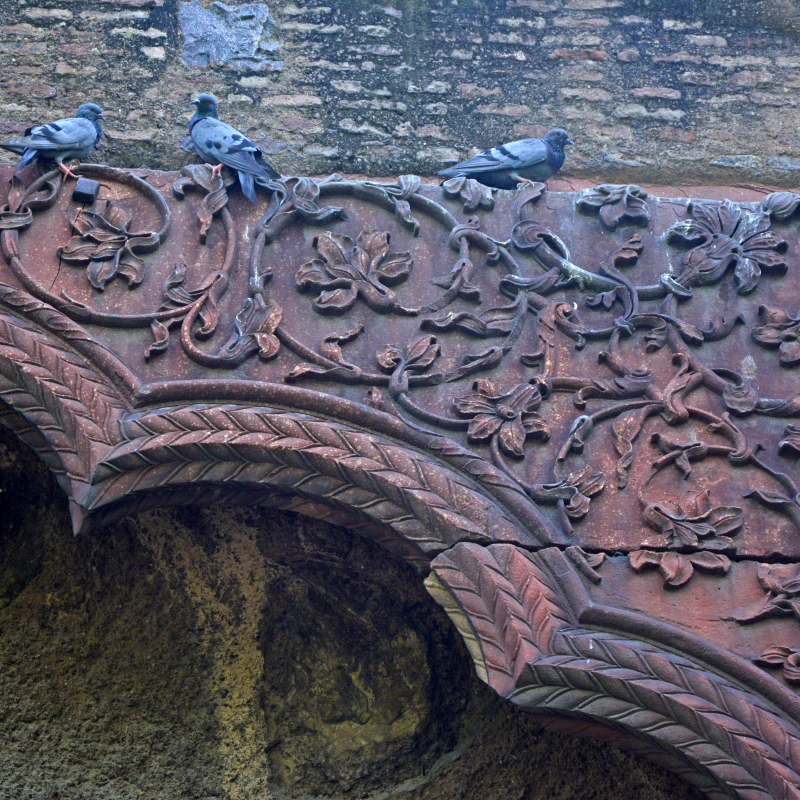From the time of its inception in the mid–17th century, the physical and cultural fabric of Shahjahanabad has borne the stamp of women patrons. Some women during the Mughal era enjoyed considerable wealth and influence. They could inherit and own landed and other property, and this gave them the independence to spend it, among other things, on the patronage of the arts. Royal ladies also received royal titles, and allowances, sometimes very large ones. Much of what survives in the city of Shahjahanabad today reminds us of these women and their lives.
The plan of the imperial capital city was given overall shape by the royal builders under the supervision of the emperor Shahjahan himself. In its details, however, it incorporated different degrees of centralized design and individual effort. Imperial diktat determined the encircling city wall and the two main streets, running north–south and east–west respectively, at their junction the palace complex (which we now know as Red Fort) and the congregational mosque, the Jama Masjid (Blake 1993, Chenoy 1998). Within the limits of this centralized plan, it was mainly individual enterprise that led to the creation of commercial spaces, places of worship, public spaces and homes.
Among the most prominent landmarks of the new imperial city were its mosques, and of these, three were commissioned by the wives of Shahjahan. After the death of his beloved wife Mumtaz Mahal, his chief consort was Akbarabadi Begum. Her title refers to Akbarabad, or Agra. It was customary among the Mughals to refer to royal consorts not by their given name but by the place of their origin, out of respect (Begley and Desai 1990:446). Akbarabadi Begum built a grand mosque to the south of the Red Fort complex (Khan 2000:284–85). The British demolished this mosque after the Revolt of 1857, as a move to clear a space around the Fort for security reasons. Shahjahan also presented Akbarabadi Begum with a garden that had been laid out at some distance from Shahjahanabad, in the north-west. This garden was known as Bagh Aizzabad or Shalimar. Akbarabadi Begum then, with her own money, built a sarai within it. A landmark event that later took place in the garden was the coronation of Aurangzeb, on the July 31, 1658, after he had deposed Shahjahan (Begley and Desai 1990:451).
Another wife of the emperor, Fatehpuri Begum, built a mosque at the western end of the street that led from the Red Fort, which is still known by her name (Fatehpuri Masjid). The Sirhindi Masjid, just outside the wall of the city, to the west, was built by another wife of the emperor, Sirhindi Begum (Hasan 2008:255).
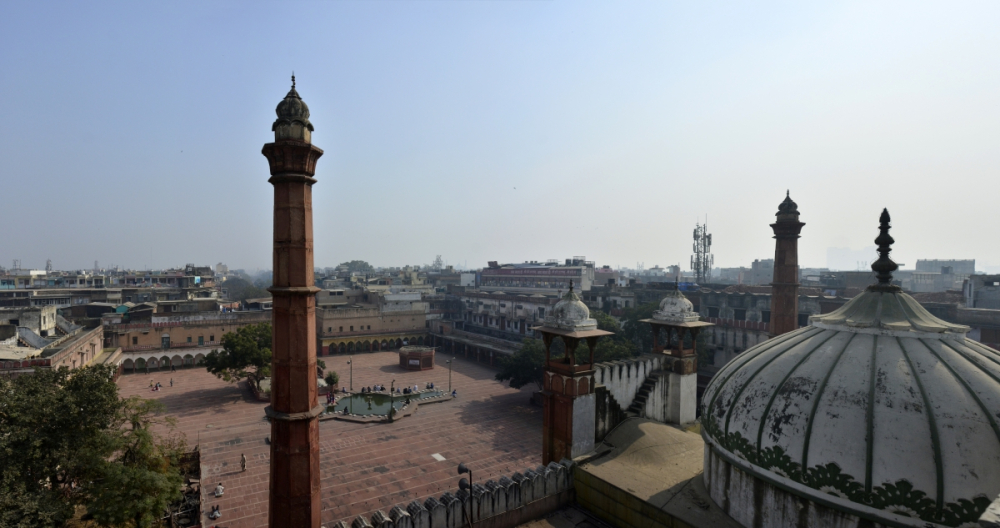
Shahjahan’s favourite daughter Jahanara was 26 years old in 1639, when work began on the new city. Though young, she commanded great influence and resources. She was a well-educated woman, learned in Persian and the Quran. She also had leanings towards the Sufi path, and had been initiated into the Chishtiya and Qadiriya orders. After the death of her mother, she had taken her place as the first lady of the empire. She was also extremely wealthy, as she had inherited property worth more than 50 lakhs of rupees, which was half of her mother’s fortune. In 1644, she had been given the revenues of the province and fort of Surat, which amounted annually to over 10 lakhs of rupees. She also had investments in trading enterprises—particularly in trade with the Dutch East India Company.
Her wealth enabled her to patronize works of learning, particularly Sufi works, such as commentaries on Maulana Rumi’s Masnavi (Schimmel 2005:151–53). She was also responsible for commissioning numerous architectural projects. In Shahjahanabad, the most important of these was the beautiful square known as Chandni Chowk. This lay on the broad street leading westwards from the palace complex. In the middle of this street ran a stream of water, and at this square it broadened to form a pool. To the north of the square was a grand sarai, where prosperous traders used to stay. To the south of the chowk was a hammam, or public bath. The chowk was a bustling public and commercial space, with many shops and coffee houses. After the Revolt of 1857, the British demolished the chowk and the buildings around it. A town hall was later built at the site of the sarai.
Jahanara was also responsible for the upkeep of the garden that occupied a large space to the north of Chandni Chowk. This had been laid out by Makramat Khan, the superintendent of the construction of Shahjahanabad. This was then presented to the princess by her father, and came to be called Bagh Sahibabad, after her title, Begum Sahib (Chenoy 1998:45, Hasan 2008:156–57). Some of this garden still survives, though in a changed form. A large part of it was cleared to make way for the railway line, which was built in the 1860s. She also commissioned a garden outside the city walls, known as the Tis Hazari Bagh. Jahanara’s younger sister, Roshanara, was also responsible for laying out a garden outside the walls of the city. This was named after her, Roshanara Bagh. A pavilion inside this garden became her eventual resting place (Hasan 2008:266–67).
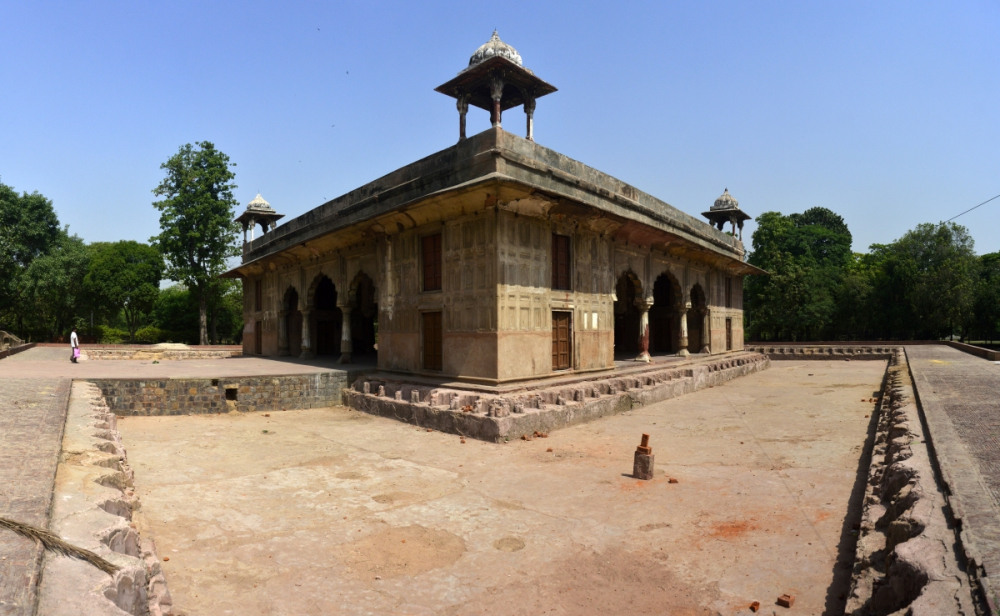
Fig. 2: Panoramic view of pavilion inside the Roshanara Bagh
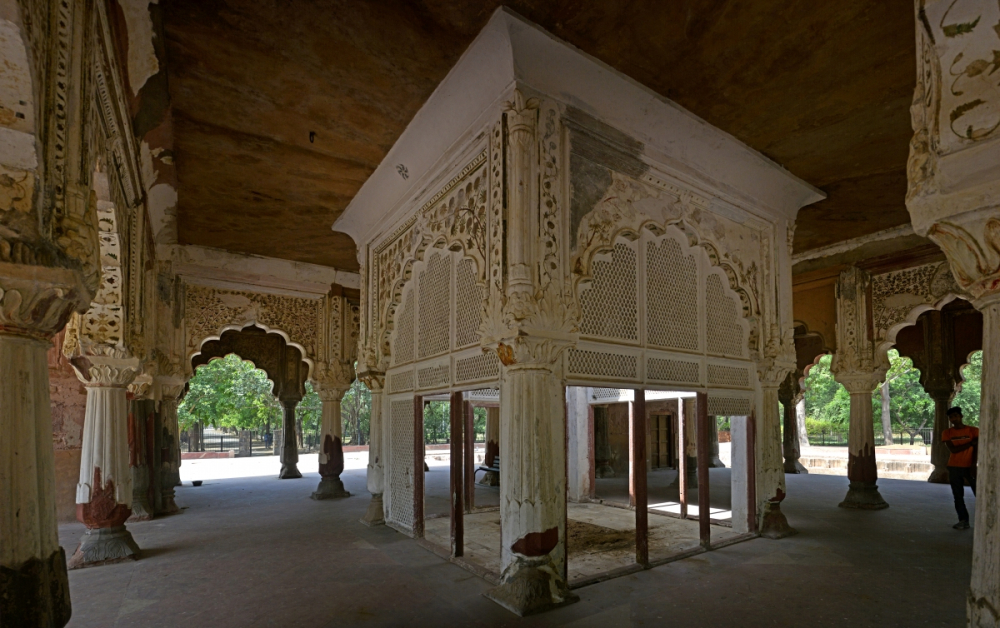
Fig. 3: Roshanara's tomb surrounded by a marble screen in the open centre of the pavilion
The next generation of Mughal royal ladies also continued the tradition of sponsoring construction and learning. Aurangzeb’s wife, Aurangabadi Begum built a mosque near the Lahore gate of the city (Khan 2000:299). His two daughters, Zinat un Nissa and Zeb un Nissa, were also patrons in their own way. Zeb un Nissa was a spiritual person, and close to her aunt, Jahanara. She was a well-educated woman, adept in Arabic and Persian, and wrote both prose and poetry. She is believed to be the author of a number of poems composed under the takhallus (alias), ‘Makhfi’. The princess was also a skilled calligraphist. She patronized many writers, poets, calligraphists and learned men and commissioned several important books and tracts. She had a large collection of books, and employed writers to make manuscript copies of books for her (Schimmel 2005:153–54). When she died, she was buried in the Tees Hazari Bagh, which she had inherited from Jahanara (Khan 1947:275).
Her sister Zinat un Nissa extended her patronage to the construction of a grand mosque beside the river, to the south of the fort, in 1700. It was called Zinat ul Masajid, and is today also popularly called Ghata Masjid. Her tomb was to the north of the mosque, but this was demolished in the aftermath of the Revolt. The mosque itself was used as a bakery for troops for many years after the Revolt (Hasan 2008:31).
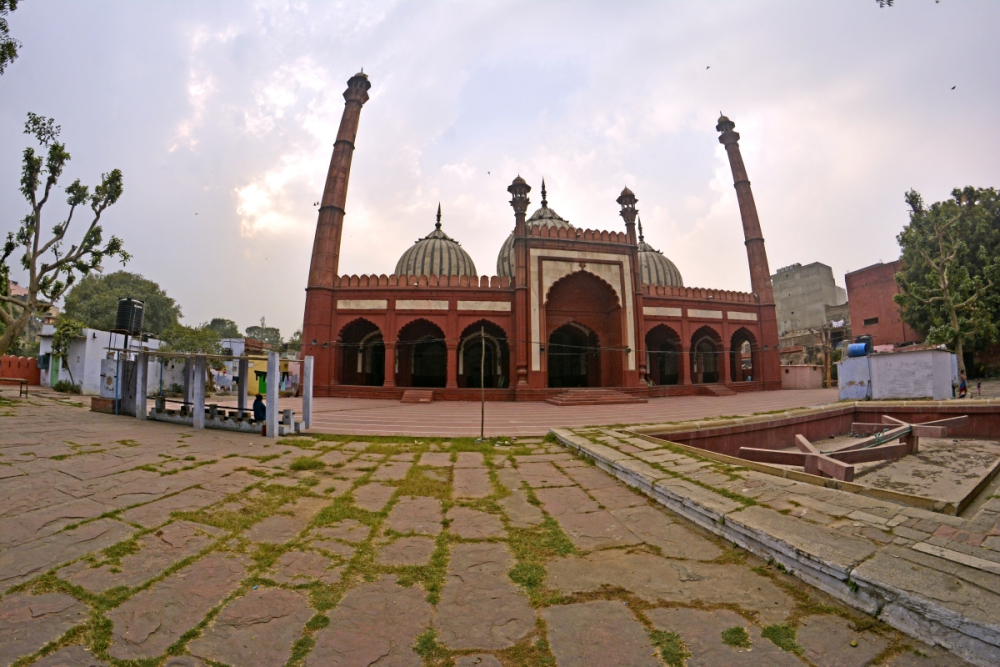
Fig. 4: Panoramic view of Zinat ul Masajid (Ghata Masjid)
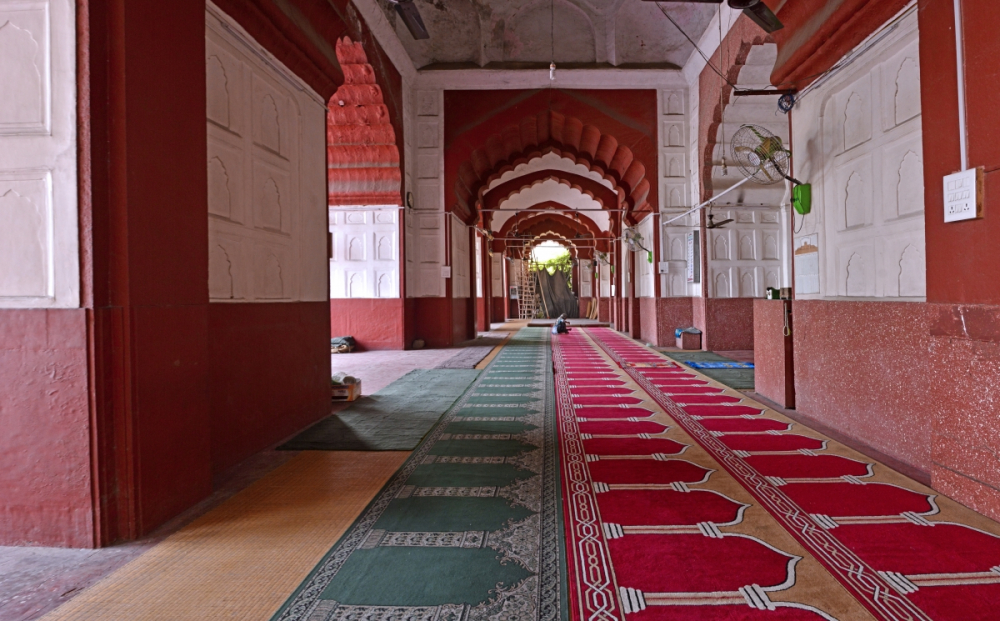
Fig. 5: Inside Zinat ul Masajid
It was not only Mughal royal ladies who built mosques and other public and private buildings in the new city. A lady called Khair un Nissa built a mosque known as Anarwali Masjid, in 1660-61, close to Khidki Farrashkhana, a western gate of the city (Hasan 2008:89).
The 18th century proved to be a time of trouble for the city of Shahjahanabad. It was looted and/or burnt more than once—by the Persian invader Nadir Shah in 1739, by the Afghan Ahmad Shah Abdali in 1757, and the Rohilla chieftain Ghulam Qadir in 1788, and several other lesser plunderers. Remarkably though, construction did not altogether stop, and royal ladies of the 18th century continued to be patrons. One important figure was that of Qudsia Begum, the mother of the emperor Ahmad Shah. She had been a dancing girl called Udham Bai before she married the emperor Muhammad Shah. She reached the pinnacle of her power when her son ascended the throne, and in fact ran the affairs of state in conjunction with Javed Khan, the eunuch in charge of the royal harem. She also was known for her charity (Hasan 2008:29–30).
The name of Qudsia Begum is associated with a garden that she laid out immediately to the north of the city—Qudsia Bagh. This garden, built in 1848, had grand buildings and a mosque, but they were all badly damaged during the Revolt of 1857. Subsequently, the garden lost its original layout and many of the buildings were demolished or modified.
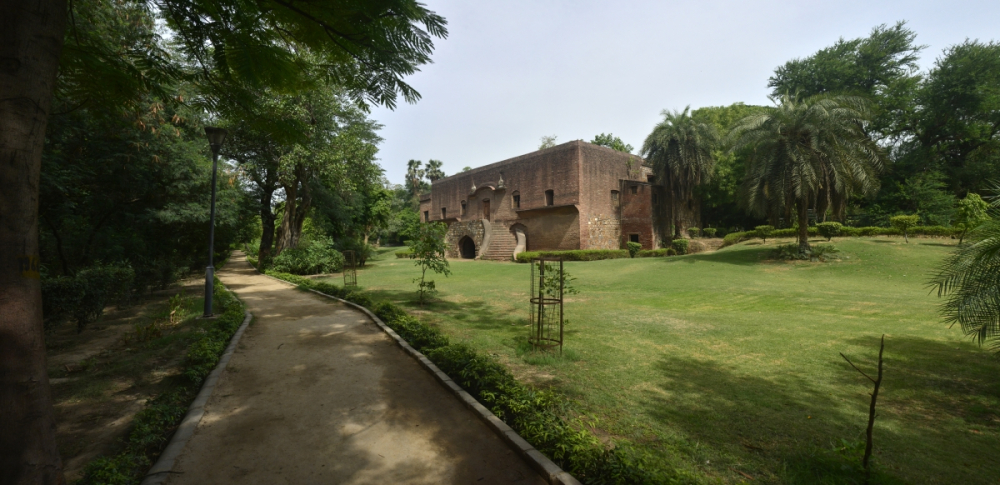
Fig. 6: A panoramic view of Qudsia Bagh
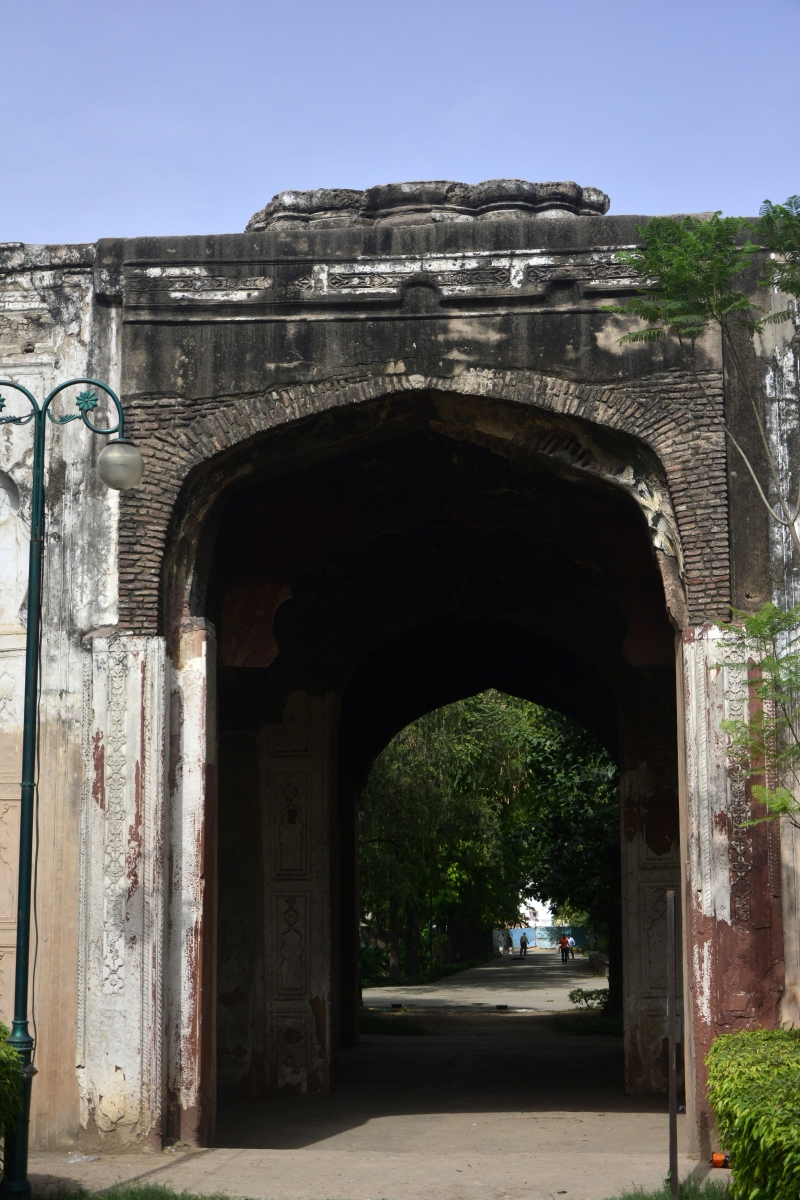
Fig. 7: Gateway to Qudsia Bagh
Qudsia Begum is also credited, together with Javed Khan, with the construction of a small mosque near the southern gate of the Red Fort. This mosque was built in 1751 and is known as Sunehri Masjid, because originally its domes were gilt covered. Qudsiaa Begum was a Shia by faith, and also constructed a number of buildings within an enclosure, at the Dargah Shah e Mardan, the shrine of the footprint of Ali, which is situated to the south of present day Lodi Garden (Hasan 2008:195–203).
Members of the royal family were not the only women who commissioned construction work. The mosque known as Fakhr ul Masajid, near Kashmiri Gate, was built in 1728–29 by Kaniz Fatima in memory of her husband Shujat Khan, a noble at the court of Aurangzeb.
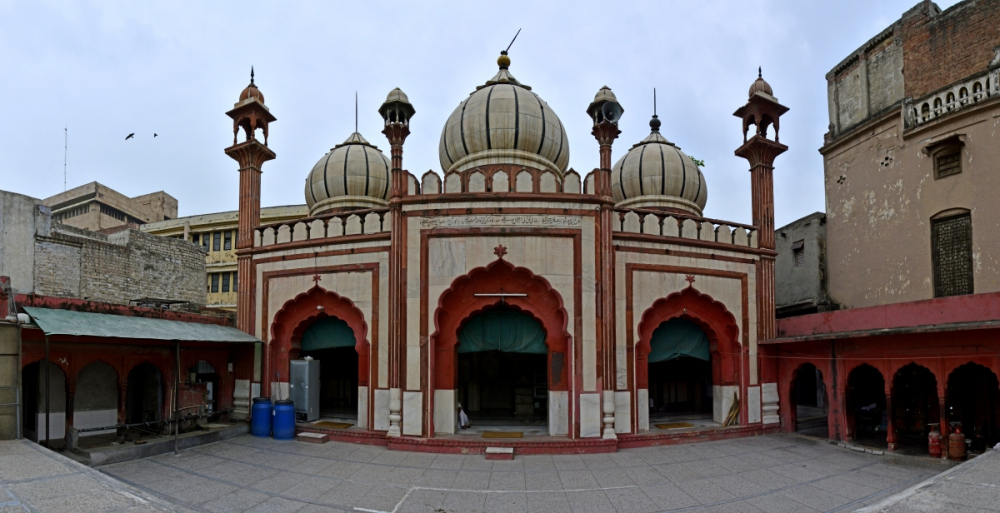
Fig. 8: Panoramic view of Fakhr ul Masajid
Later in the 18th century a palatial house was built south of the Jama Masjid on the orders of Rabia Begum, who was the wife of Muhammad Khan Bangash, the governor of Farukkhabad, Agra and Allahabad. She is believed to have commissioned a number of other structures too, including probably the bridge known as Pul Bangash. Another lady, also called Rabia Begum, built a mosque in memory of her husband Painda Khan, a general who died in 1786-87 (Hasan 2008 :49, 80–81,183–84).
There are localities and havelis within Shahjahanabad named after women. These no doubt get their names from mansions that were owned by these women, but we are not entirely sure how much of a hand they had in their construction. For instance, the daughters of Qamr ud Din Khan, the wazir or chief minister of emperor Muhammad Shah, had property near Ajmeri gate. Two lanes, called Gali Shah Tara, and Gali Razia Begum (a corruption of Razi un Nissa Begum) are named after them (Hasan 2008:81–82).
Some buildings in Shahjahanabad are named after unknown women patrons, such as the two so-called Burhiyas’ mosques, named after some old women of whom nothing is now known. The names of others are preserved on inscriptions within the buildings, even though historical details of the patrons are lost. For instance, the two ladies who built the mosque known as Mir Afzal’s mosque, in the Lal Kuan locality in 1806. In fact, in the first half of the 19th century, there were a number of mosques and temples built by women. These included at least three mosques other than the ones mentioned above, a Kali temple and several Shiva temples (Hasan 2008:63, 178, 194, 100, 101, 114, 119, 131, 157, 161–62, 166, 181).
Other women patrons of the 19th century were better known. In 1822-23, a mosque and adjacent house were built by Mubarak Begum, the wife of General David Ochterlony. Ochterlony was a military commander and the first ‘Resident’—representing the East India Company’s government immediately after Delhi was conquered by the British. Mubarak Begum wielded a lot of influence, and the gossip was that she accepted large bribes in the name of her husband. Though she had adopted the high title of Mubarak Begum, her past was not forgotten, and the mosque came to be popularly known as Randi ki Masjid—the ‘prostitute’s mosque’ (Hasan 2008:83).
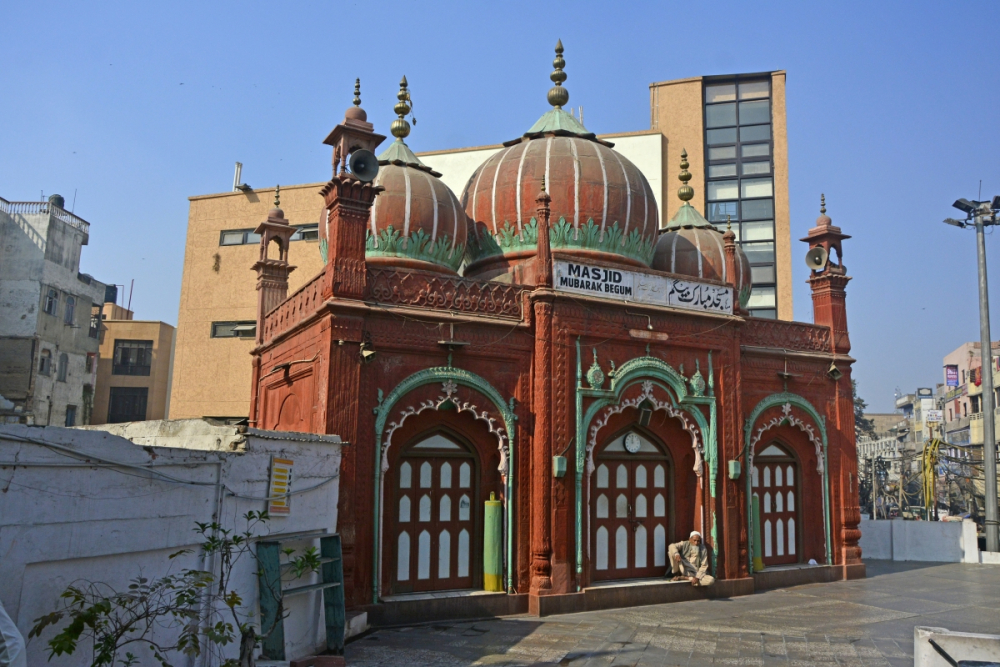
Fig. 9: Mubarak Begum Masjid
A prominent woman figure of late 18th- and 19th-century north India was Begum Samru. Her given name was Farzana and she was a Kashmiri dancing girl who had married the European military freelancer Walter Reinhardt ‘Sombre’. Walter Reinhardt had come to India in the middle of the 18th century and made his fortune as a military soldier. His nickname, Sombre, or ‘dark’ was corrupted to Samru, and his wife came to be known as Begum Samru. After his death, she inherited his estate of Sardhana, which is in present day Meerut district. She also successfully led his military force and made astute political alliances. For her support in the war with the Marathas, the British East India Company confirmed her jagir. Though her headquarter was in Sardhana, the begum spent much of her time in Delhi, where she interacted with British officialdom as well as the Mughal Royal family, which was presided over by the emperor Akbar II. In 1806, Begum Samru acquired a prime piece of land in the heart of the city and on this she built a grand house set in a large garden. This was one of the earliest purely European classical-style mansions built in Shahjahanabad. After her death this building came to be occupied by the Delhi Bank, which was badly damaged during the Revolt of 1857. At a later date, the building was bought by Lala Bhagirath, and came to be known as Bhagirath Palace, as it continues to be called today (Masselos and Gupta 2011:64; Khan 2000:709).
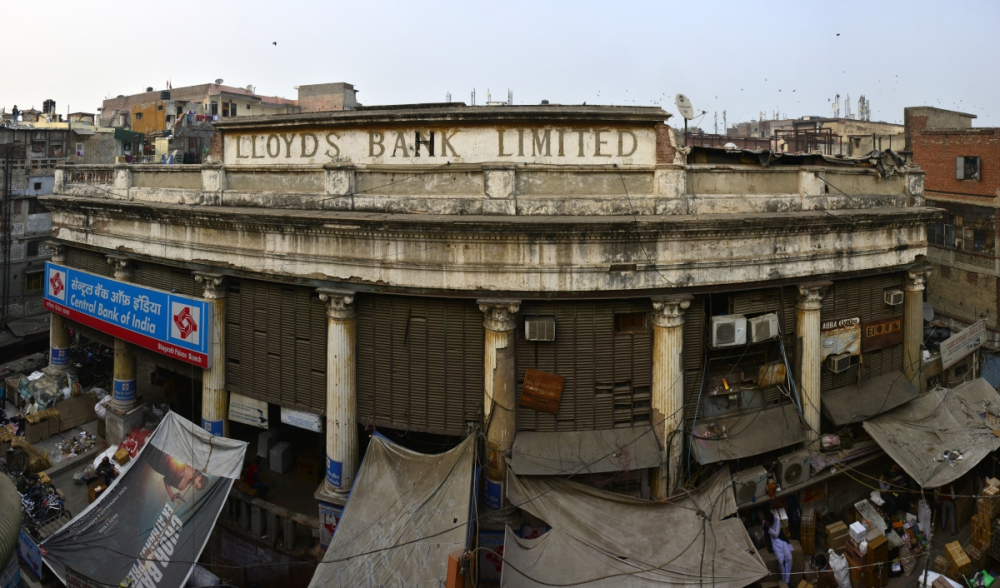
Fig.10: A panoramic view of the dilapidated Delhi Bank. Also known as Bhagirath Palace.
By the mid–19th century, the Mughal empire was a thing of the past. The British East India Company was the master of Delhi as it was of large parts of India. The descendants of the Mughal emperor lived in the Red Fort on a relatively meagre allowance from the Company’s Government. Nevertheless the emperor and the royal family continued to spend what they could on construction. Zinat Mahal was the wife which the last Mughal emperor, Bahadur Shah ‘Zafar’ had married in 1840. She soon became a powerful influence within the palace, and controlled a good deal of wealth. In 1846, she built a mansion in the locality known as Lal Kuan Bazar. Her aim was to establish herself in the city, so that when the emperor died, her property and person would not be under the jurisdiction of the new emperor, who might be one of the emperor’s older sons.
She started to spend increasing amounts of time in this haveli, away from the Red Fort. This was done with the permission of Bahadur Shah, and in fact he also visited the mansion from time to time. The mansion itself has not stood the test of time, and new construction has taken its place. A dilapidated gate however still exists (Hasan 2008:98).
The women of Shahjahanabad have contributed much to its built fabric and culture. Though many buildings have been lost through the many upheavals the city has been through, there are enough left to remind us of those women.
References and Further Reading
Begley, W.E. and Z.A. Desai. 1990. The Shah Jahan Nama of Inayat Khan, trans. A.R. Fulley. Delhi: Oxford University Press.
Blake, Stephen P. 1993.Shahjahanabad: The Sovereign City in Mughal India,1639-1739. New Delhi: Cambridge University Press.
Chenoy, Shama Mitra. 1998. Shahjahanabad: A City of Delhi 1638–1857. New Delhi: Munshiram Manoharlal.
Hasan, Zafar. 2008 [1916]. Monuments of Delhi: Lasting Splendour of Great Mughals and the others. Delhi: Aryan Books International.
Khan, Saqi Mustaid. 1947 [1870–73] . Maasir e Alamgiri. Translated by Jadunath Sarkar. Calcutta: Royal Asiatic Society.
Khan, Syed Ahmed. 2000 [1854]. Asarussanadid. Delhi: Urdu Akademi.
Masselos, Jim and Narayani Gupta. 2011 [1997]. Beato’s Delhi. New Delhi: Penguin.
Schimmel, Annemarie. 2005. The Empire of the Great Mughals: History, Art and Culture. New Delhi: Oxford University Press.
Note
Maasir e Alamgiri by Mohammed Saqi Mustaid Khan is an important Persian work about Aurangzeb’s rule written immediately after the death of the emperor in 1707 by a mansabdar of Aurangzeb. It was translated into English by Jadunath Sarkar and later translated into Urdu by Maulvi Mohammed Fida Ali Talib.
